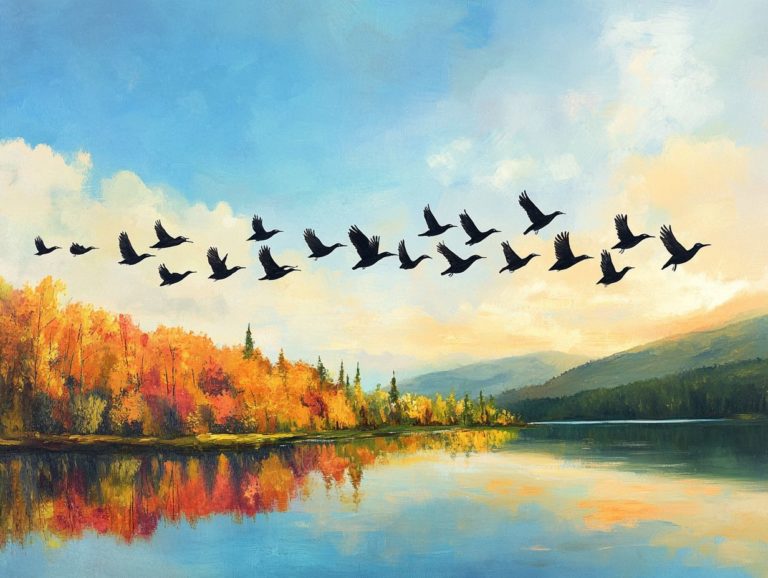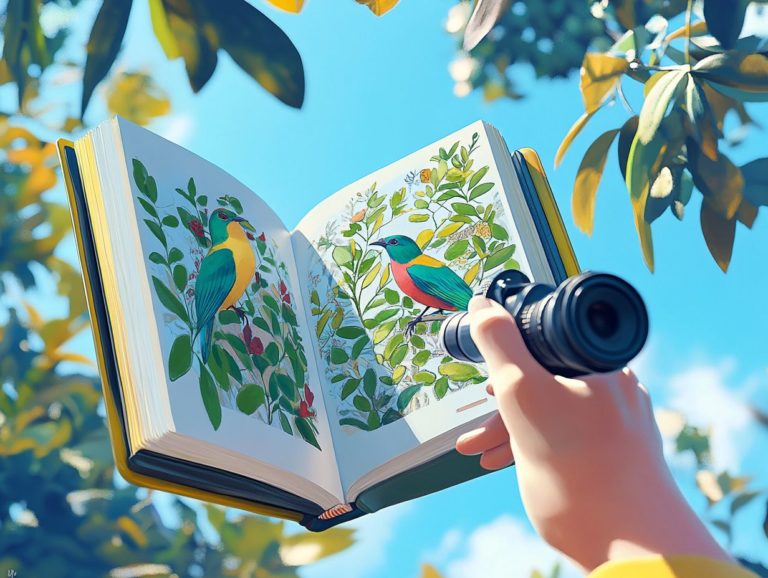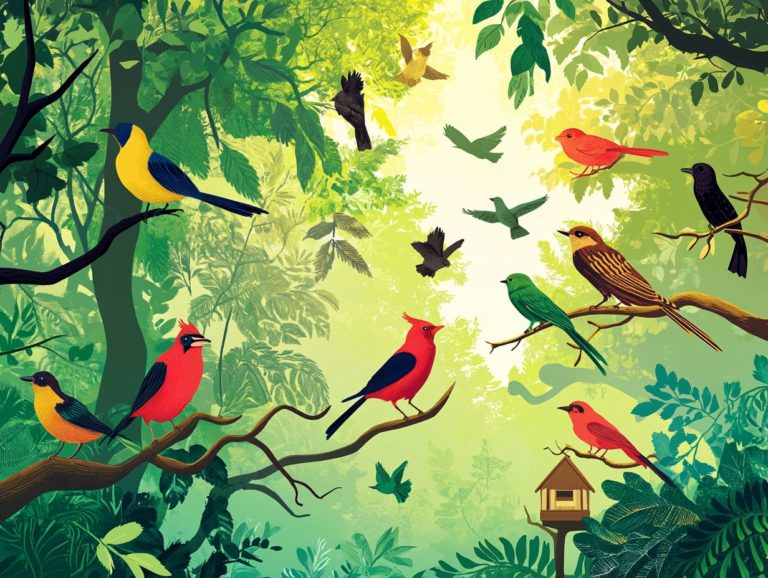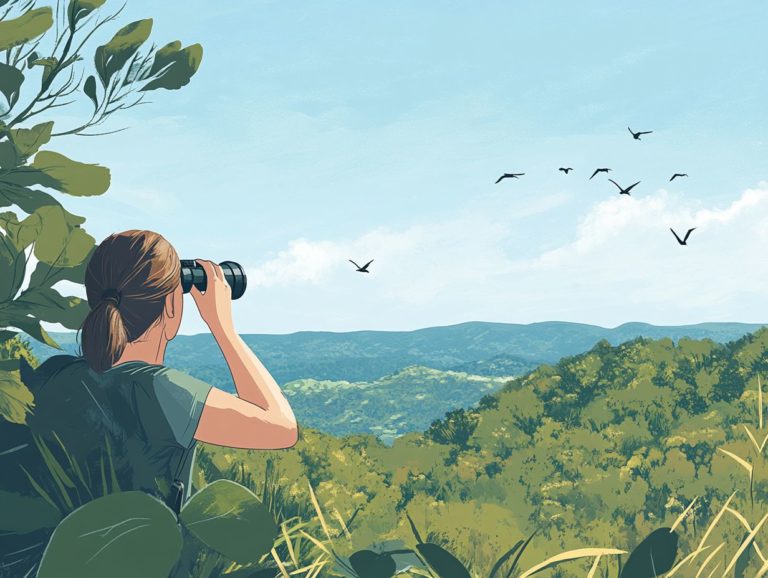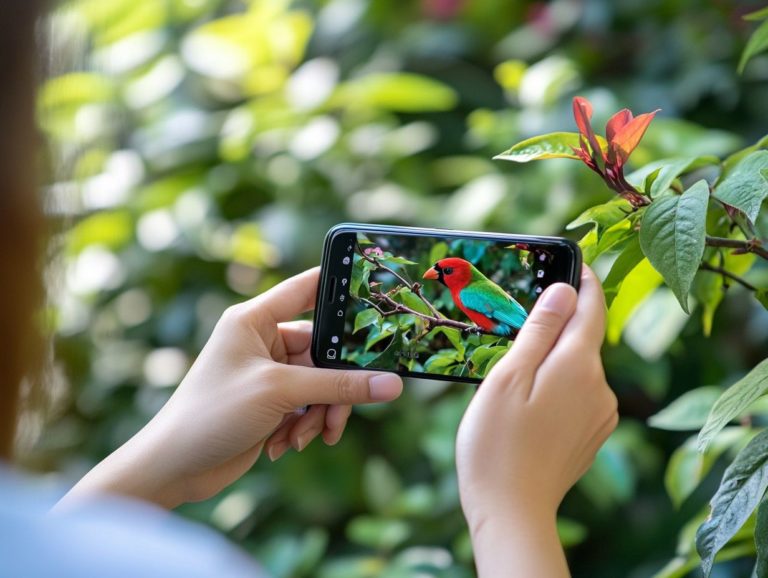5 Tips for Bird Watching in National Parks
Get ready to connect with nature and spot stunning birds in national parks! Birdwatching in these beautiful settings is an excellent way to observe amazing bird species in their natural habitats. Whether you are an experienced birdwatcher or just starting, here are some important tips to enhance your experience.
Here are essential tips for birdwatching in national parks that will guide you:
- Do some research on the park
- Understand the benefits of birdwatching
- Recognize common mistakes to avoid
- Discover the unique species you might encounter
Enjoy a great birdwatching experience in national parks!
Contents
- Key Takeaways:
- 1. Research the Park and Its Bird Species
- 2. Bring the Right Equipment
- 3. Follow Park Rules and Regulations
- 4. Be Respectful of the Environment
- 5. Join a Guided Bird Watching Tour
- What Are the Top National Parks for Bird Watching?
- What Are Some Common Mistakes to Avoid While Bird Watching in National Parks?
- How Can One Make the Most of Their Bird Watching Experience in National Parks?
- What Are Some Unique Bird Species to Look Out for in National Parks?
- How Can Bird Watching in National Parks Contribute to Conservation Efforts?
- Frequently Asked Questions
- What are some general tips for bird watching in national parks?
- Which national parks are known for their diverse bird populations?
- What should I wear for bird watching in national parks?
- What other equipment should I bring for bird watching in national parks?
- Are there guided bird watching tours available in national parks?
- Can I go bird watching in national parks during any season?
Key Takeaways:
- Research the park and its bird species to boost your chances of spotting unique birds.
- Pack essential gear like binoculars and a field guide for an amazing birdwatching adventure.
- Follow park rules to protect yourself and the birds.
1. Research the Park and Its Bird Species
Before visiting a national park, do some research on the specific bird species present. This knowledge will enhance your birding experience.
Learning about local birds, their habitats, and when they come and go will help you recognize them easily while you’re out exploring. Resources like bird guides, mobile applications, and reliable online platforms such as Audubon magazine and eBird can assist you in this endeavor.
These resources inform you about different bird species and highlight specific characteristics to look for in each park. By learning to identify these species, you will enrich your birding experience and gain a deeper awareness of the ecosystems within the parks.
This newfound awareness can lead to a more rewarding experience as you connect with nature and observe diverse birds engaging in their activities.
2. Bring the Right Equipment
Having the right equipment is essential for birdwatching. Quality binoculars can significantly enhance your observation and identification of birds in their natural habitats. The specifications of binoculars, such as how much closer you can see the birds and field of view, play a crucial role in how effectively you can spot and track them.
A magnification range of 8x to 10x strikes a good balance, allowing for close observation while minimizing image shake. A wider field of view is particularly beneficial for spotting fast-moving birds. Binoculars are often used alongside a reliable bird guide, which offers additional assistance for quickly identifying observed species.
If you’re interested in photography, a good camera lens and a sturdy tripod are crucial for capturing stunning moments in the wild and ensuring that photographs of nature are as beautiful as they can be.
3. Follow Park Rules and Regulations
Stick to park rules to keep yourself and the birds safe. It’s crucial for their survival and for preserving birds’ habitats and the overall integrity of wildlife spaces frequented by birders. Following specific guidelines helps create a safe environment for birds.
For instance, maintaining a proper distance from nesting birds is crucial. Getting too close can disrupt their breeding and reduce their chances of survival. Feeding wildlife is generally against regulations because it can cause birds to become dependent on humans, diminishing their natural foraging instincts.
Birding enthusiasts play a vital role in promoting these regulations. Their passion for observing wildlife often translates into a commitment to the rules that safeguard these creatures, reinforcing environmental awareness. They can encourage fellow nature lovers to appreciate the habitats of the animals they admire while avoiding disturbances to nests or habitats.
4. Be Respectful of the Environment
For birdwatchers, respecting the environment is crucial. Responsible birding practices significantly contribute to bird conservation and the protection of ecosystems where various bird species live and thrive.
By minimizing disturbances in wildlife areas, enthusiasts can ensure that natural habitats remain undisturbed. This allows birds to mate, nest, and flourish within their ecosystems.
Adhering to the Leave No Trace principles is essential. Sticking to designated paths prevents habitat destruction, while avoiding litter keeps the area clean and safe for wildlife.
If anyone witnesses harmful acts such as poaching or littering, reporting these incidents can help safeguard these vital habitats. By taking these actions, birdwatchers can enjoy their hobby while respecting the environment.
5. Join a Guided Bird Watching Tour
Participating in a guided birdwatching tour can significantly enhance your birding experience. Expert insights into local bird species, their habitats, and effective methods for observing birds are invaluable.
Joining birding clubs or organizations allows enthusiasts to connect with like-minded individuals who share a passion for avian observation. Learning from seasoned birders helps you hone your skills and enriches your knowledge about migratory patterns and nesting behaviors.
These clubs often organize events that encourage networking among members. This fosters friendships and collaborative learning, leading to exciting new opportunities.
Engaging with the birding community ignites a deeper appreciation for nature, transforming casual observers into informed advocates for bird conservation.
What Are the Top National Parks for Bird Watching?
Birdwatching in national parks around the world offers some of the best opportunities for bird enthusiasts. Each park features unique wildlife areas and bird species, making them popular destinations for birders and nature lovers alike.
Rocky Mountain National Park boasts the greatest diversity of habitats in Colorado, ranging from low montane forests to high alpine tundra. This incredible variety draws in countless bird species, making each visit thrilling!
You can spot the American Dipper, various types of finches, crossbills, and Rosy-Finches. Birdwatching is particularly rewarding in the spring and fall when migratory birds are most active.
Cape Cod National Seashore provides a coastal environment rich in migratory shorebirds, including the endangered Piping Plover. The summer months are the best time to observe these birds as they forage and nest in the sandy beach dunes and tidal flats.
Everglades National Park, the largest subtropical wilderness in the United States, is home to extensive wetlands. Here, you can find many species of wading birds, such as herons, egrets, and ibises.
Don’t miss out on the winter months when observing these stunning birds is at its peak!
What Are the Benefits of Bird Watching in National Parks?
Bird watching in national parks offers numerous benefits, including a deeper appreciation for nature and opportunities to interact with local bird communities.
This tranquil activity fosters an understanding of the delicate balance within ecosystems, enabling participants to observe the unique behaviors of various birds up close.
Spending time outdoors reduces stress and anxiety, providing psychological benefits associated with immersion in natural environments.
The camaraderie among birdwatchers enriches the experience. They share tips, discoveries, and stories, cultivating friendships that inspire collective action to protect our environment.
What Are Some Common Mistakes to Avoid While Bird Watching in National Parks?
Novice birdwatchers often make common mistakes. Common errors include getting too close to birds, not using the appropriate birding tools, and neglecting to learn bird identification methods. Many enthusiasts overlook seasonal birds, which can lead to missed opportunities to spot unique species.
Misunderstanding bird calls is a common mistake. Learning to distinguish between similar calls can significantly enhance your observations.
One effective way to improve these skills is to invest in quality binoculars or a field guide. These tools assist in identifying various species. Practicing patience and keeping a respectful distance from birds can lead to a more rewarding experience.
Local birding groups or apps designed for real-time call identification can provide valuable insights and improve your understanding of bird behavior.
How Can One Make the Most of Their Bird Watching Experience in National Parks?
To enhance your birdwatching experience in national parks, consider using effective birding techniques and improving your observation skills. Practice identifying various bird species in their natural habitats.
The best times for birdwatching are early mornings and late afternoons. These times help maximize the number of species you encounter. Mobile apps can assist in identifying birds by providing immediate information and images.
Keeping a bird log is an exciting way to track your sightings. It helps foster a deeper connection with nature through more frequent engagement. Additionally, patience and strong listening skills are crucial for hearing birds even when they are not visible.
What Are Some Unique Bird Species to Look Out for in National Parks?
National parks are home to a diverse array of unique bird species and common birds. These vary by region and season, providing birding enthusiasts with exceptional opportunities to observe and document them in their natural habitats.
From the vibrant painted bunting found in the southern states to the majestic bald eagle soaring over mountainous regions, each national park fosters its own distinct avian ecosystem.
Seasonal changes significantly affect bird visibility. For instance, migratory species travel to warmer climates in the spring, making Everglades National Park particularly lively with birds. In autumn, dark-eyed juncos become abundant as they forage for food to prepare for winter.
Participating in local birding programs can enhance your experience. These programs offer guided tours that highlight unique species and promote awareness of their habitats.
How Can Bird Watching in National Parks Contribute to Conservation Efforts?
Bird watching in national parks plays a significant role in conservation efforts. It raises awareness about avian species, their habitats, and the environmental challenges they face. This activity fosters cooperation within the birding community and birding clubs.
Events that invite birdwatchers to visit and document their observations contribute to a vast data pool. Utilize eBird to track your sightings effectively. This crowd-sourced data enables scientists to monitor population trends and migration patterns, essential for effective conservation strategies.
Birdwatchers become crucial stewards of the ecosystem. Their collective observations have led to successful initiatives like habitat restoration projects and funding for endangered species conservation. By integrating technology with their passion, the birding community not only enjoys the beauty of nature but also plays a vital role in its preservation.
Frequently Asked Questions
What are some general tips for bird watching in national parks?
1. Start early in the morning: Birds are most active during the early hours, so plan to start your bird watching adventure at sunrise.
2. Bring your binoculars for a better view: A good pair of binoculars can make a huge difference in spotting and identifying different bird species.
3. Be patient and quiet: Birds are easily scared off by loud noises and sudden movements, so be patient and move quietly to increase your chances of seeing them.
4. Research the area beforehand: Before heading to a national park, do some research on the types of bird species that can be found in the area and their habitats.
5. Respect the birds and their habitats: Make sure to follow park rules and regulations, and avoid disturbing the birds or their nesting areas.
Which national parks are known for their diverse bird populations?
Some popular national parks for bird watching include:
1. Everglades National Park in Florida, known for its abundance of wading birds and raptors.
2. Great Smoky Mountains National Park in North Carolina and Tennessee, home to over 240 species of birds.
3. Yellowstone National Park in Wyoming, Montana, and Idaho, where you can spot a variety of birds such as ospreys, eagles, and sandhill cranes.
4. Acadia National Park in Maine, where you can see seabirds and songbirds in their natural habitats.
5. Grand Canyon National Park in Arizona, where you can find a diverse range of bird species, including the rare California Condor.
What should I wear for bird watching in national parks?
Dress smart for your bird watching adventure! It makes a big difference.
1. Wear neutral colors. Avoid bright or vibrant colors that may startle the birds.
2. Choose comfortable and weather-appropriate clothing: Wear layers in case of changing weather conditions, and make sure to wear comfortable shoes for walking.
3. Cover up: Protect yourself from the sun and bugs by wearing long-sleeved shirts, pants, and a hat.
4. Bring rain gear: Be prepared for rain by bringing a waterproof jacket or poncho.
5. Avoid strong scents: Refrain from wearing strong perfumes or lotions, as the scent may deter birds from coming near you.
What other equipment should I bring for bird watching in national parks?
In addition to binoculars, here are some other recommended equipment to bring for your bird watching adventure:
1. Field guide: Use bird identification apps to help you identify different bird species.
2. Camera: Capture your bird sightings with a camera to document your experience.
3. Notebook and pen: Take notes on the birds you see, their behaviors, and other observations.
4. Snacks and water: Stay hydrated and energized by packing snacks and water for your trip.
5. Insect repellent: Protect yourself from bugs by bringing insect repellent.
Are there guided bird watching tours available in national parks?
Many national parks offer guided bird watching tours led by knowledgeable park rangers or experienced birders. These tours can provide valuable information on local bird species and their habitats, as well as increase your chances of spotting rare or elusive birds. Don’t miss out! Check with the national park’s visitor center for available tours.
Can I go bird watching in national parks during any season?
Yes, you can go bird watching in national parks all year round. Different seasons may offer different bird species and behaviors.
For example, spring and fall are peak migration seasons, so you may see a larger variety of birds during these times. Winter can also be a great time for bird watching, as some birds that are not typically found in the area may migrate there for the season.
Do some research on the best time to visit a national park for bird watching based on the species you are interested in seeing.
Get your binoculars ready and plan your bird watching trip today!

